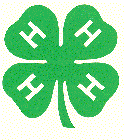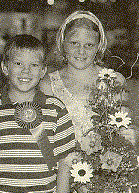 The Evolution of 4-H
The Evolution of 4-H
4-H began right here in Ohio--Clark County to be more specific. On January 15, 1902, Mr. Albert Belmont Graham, the superintendent of the Springfield Township Schools, organized a meeting with some thirty boys and girls in the county courthouse basement. The intent of the meeting was to learn more about harvesting corn, planting a garden, testing soil samples, tying knots in ropes and identifying natural wildlife such as weeds and insects. Eventually, the group came to be called the "Boy's and Girl's Agricultural Club" with their research continuing well into 1903. Prizes were given to recognize the efforts of all the members who executed projects based on the previously mentioned categories. Given the success of Graham's "out-of-school education program," the Ohio State University created a plan to aid the club's research through the use of the Agricultural Experiment Station and the College of Agriculture. In time, the Ohio State University's influence helped establish additional youth agricultural clubs throughout Ohio. By 1905, there were over 2,000 youths within sixteen counties partaking in similar programs to that of the original Agricultural Club. Proving extremely successful in his practices, Graham accepted the position as Superintendent of the Extension for Ohio. Once in office, Graham set the following concepts, which formed the basis for the Ohio Cooperative Extension Service:
- To elevate the standard of living in Ohio;
- To emphasize the importance of hard work and habits of industry which are essential to building a strong character;
- To aquaint boys and girls with their environment and to interest them in making their own investigations;
- To give the boys who shall become interested in farm work an elementary knowledge of agriculture and farm practices and to give girls the essential facts of domestic economy;
- To educate adults in the elementary science of agriculture and in the most-up-to-date farm practices;
- To cultivate a taste for the beautiful in nature;
- To inspire young men and women to further their education in the science of agriculture or domestic science.
In Knox County, 4-H is the youth program of the Ohio State University Extension office in Mt. Vernon, the county-seat. The Extension oversees 1,500 youth in their traditional program which is composed of some 200 different projects based upon beginning, intermediate and advanced levels. The less traditional programs consist of a juvenile diversion program for at risk youth, as well as special emphasis groups such as a local elementary school age program that resembles a day-care before and after school. In these settings, Larry Hall confirms that, "We also do 4-H programming so they do learn cooperative skills, life skills, survival skills if you will. They learn how to get along with each other and how to set their own goals, how to have little successes as they step, step-wise through life." In order for these programs to succeed, the youth and their projects are overseen by 350 volunteer advisors.
 However, when one often hears of 4-H in Knox County, one thinks of
agriculture and the County Fair. Larry Hall recalls, "When I was growing up, getting to
exhibit your project at the Fair was the highlight of the summer. And while to some audiences
that may seem kind of hokey, it really was an opportunity for you to publicly display your
knowledge, whether it be in a poster or a birdhouse, or any number of rabbits, poultry, sheep,
swine, goats, beef, dairy, horse exhibits that you can come up with. This was an opportunity for
them say, 'this is what I did and I'm proud of it' and it gives parents and grandparents and
extended family members an opportunity to beam with pride and acknowledge that these kids
have learned a lot." The traditional calendar for Knox County is that in January a "kick-off" is
held where the members are informed of upcoming events, programming, training and available
projects. The projects range from money management, tractor and machinery operation,
leadership and veterinary science. The clubs then form in late January, early February and
enrollment figures are finalized in March.
However, when one often hears of 4-H in Knox County, one thinks of
agriculture and the County Fair. Larry Hall recalls, "When I was growing up, getting to
exhibit your project at the Fair was the highlight of the summer. And while to some audiences
that may seem kind of hokey, it really was an opportunity for you to publicly display your
knowledge, whether it be in a poster or a birdhouse, or any number of rabbits, poultry, sheep,
swine, goats, beef, dairy, horse exhibits that you can come up with. This was an opportunity for
them say, 'this is what I did and I'm proud of it' and it gives parents and grandparents and
extended family members an opportunity to beam with pride and acknowledge that these kids
have learned a lot." The traditional calendar for Knox County is that in January a "kick-off" is
held where the members are informed of upcoming events, programming, training and available
projects. The projects range from money management, tractor and machinery operation,
leadership and veterinary science. The clubs then form in late January, early February and
enrollment figures are finalized in March.
 At this time, meetings begin, officers are elected, and
projects selected. Once selected, members can embark on their various projects. For instance, if
one has selected a livestock project, it is in hand by May first. The larger animals are purchased
months or even a year ahead during which time the member has assumed caring for the livestock. As
for smaller animals they are purchased on May first. There is a junior 4-H camp in June where
250 members spend five days and four nights down in Camp Ohio, just across the Licking
County line. And finally, the County Fair takes place the last full week in
July
and represents the culmination of the club's traditional activities. At the Fair there is a 4-H
program breakdown into both a Junior and Senior Fair. The Junior Fair mainly involves 4-H'ers,
FFA, Boy Scouts, Girl Scouts and their projects which
are exhibited for competition and sometimes even auction. All these events are run by the teenagers on the Junior Fair Board. Therefore, the Junior Fair is their
own, not the adults. The adults have the Senior Fair. With the conclusion of the Fair, some
members may select to take a hiatus, some to continue their project throughout the fall and winter.
At this time, meetings begin, officers are elected, and
projects selected. Once selected, members can embark on their various projects. For instance, if
one has selected a livestock project, it is in hand by May first. The larger animals are purchased
months or even a year ahead during which time the member has assumed caring for the livestock. As
for smaller animals they are purchased on May first. There is a junior 4-H camp in June where
250 members spend five days and four nights down in Camp Ohio, just across the Licking
County line. And finally, the County Fair takes place the last full week in
July
and represents the culmination of the club's traditional activities. At the Fair there is a 4-H
program breakdown into both a Junior and Senior Fair. The Junior Fair mainly involves 4-H'ers,
FFA, Boy Scouts, Girl Scouts and their projects which
are exhibited for competition and sometimes even auction. All these events are run by the teenagers on the Junior Fair Board. Therefore, the Junior Fair is their
own, not the adults. The adults have the Senior Fair. With the conclusion of the Fair, some
members may select to take a hiatus, some to continue their project throughout the fall and winter.
All in all, Larry Hall gets right to the heart of 4-H and its role in the community saying, "It's one of the oldest youth organizations in that's still going and 4-H has shown over the years that giving kids the opportunity for the hands on learning, they retain it much better and they're able to go on and teach it to someone else, so the, the see one, so one, teach one really works out in 4-H. You know, because they do get an opportunity to practice what they've learned and then, if they can pass it on to someone else, that's a success story in itself."
photo credit: various pamphlets from OSU Extension, Knox County
For more information on 4-H click


 E-Mail The Family Farm Project
E-Mail The Family Farm Project